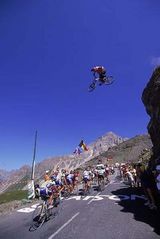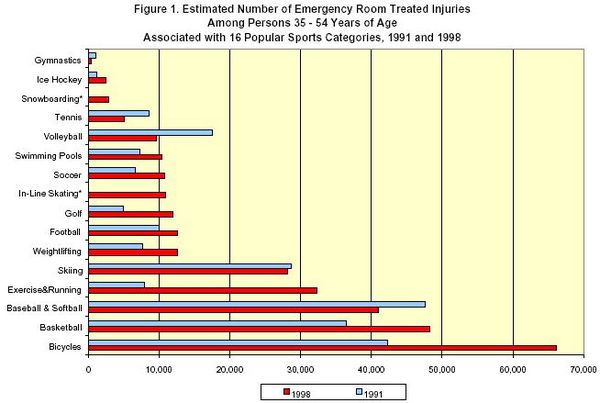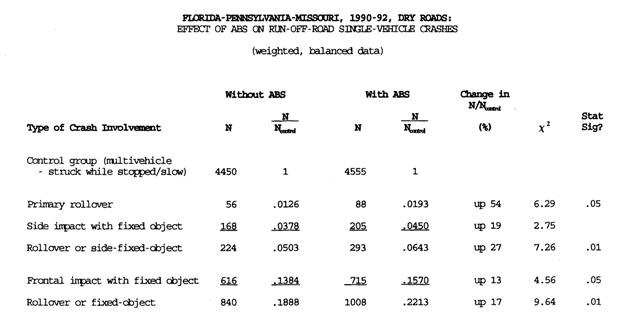T34 Group 1
Contents
Group Name
Crash Test Dummies
Group Members
Justin Maw
Scott Denoon
Miguel Torres
Angela Eaton
Initial Statement
People change their actions based on the perceived risk inherent to a specific action, combined with how much risk they are willing to take. Even with increases in safety technology, the average number of accidents remains the same. Risk is shifted not reduced.
What is Risk Homeostasis?
Human beings can never be totally sure of the outcome of a decision. According to Garold Wilde, you have already made a risky decision by opening this wiki page and reading the first few lines; who knows what can come out of this term project! You are now at another decision point: you can a) decide to read on or b) stop reading. If you choose a), there is potentially the chance in which you will think that you could have put your time to better use, but if you choose b), there is also the chance in which you will obtain a nagging feeling as if you missed out on the opportunity to learn something of importance. So I will pose the same question in which Wilde posed in his own novel, Target Risk 2: A New Psychology of Safety and Health, which of the two risky decisions do you take? Risk homeostasis is a theory about human’s perception of risk and how it affects decision-making. Garold J.S Wilde, an emeritus psychology professor from Queens University in Kingston Ontario, developed risk homeostasis and outlines his theory in his book Target Risk 2: A New Psychology of Safety and Health. This wiki is designed to outline what homeostasis is, how it applies to risk, and in what areas of technology it can apply too.
What is Homeostasis?
Homeostasis can be defined as: the tendency for a system to remain in a state of equilibrium by resisting change (www.pde.state.pa.us/a_and_t/lib/a_and_t/Science_Glossary.doc). More often than not homeostasis is considered a biological system that regulates equilibrium, but really it can help define many other systems other than the body. For example, body temperature. The human body manipulates water throughout the body in order to stabilize its temperature, mainly through sweating. This is temperature homeostasis. Homeostasis can also be applied to appliances such as clothes driers, automatic pilots, humidifiers and dehumidifiers, cruise control in automobiles, refrigerators, air conditioning units and central heating (Wilde, Gerald J.S. (20001). Target Risk 2: A New Psychology of Safety and Health.). Let’s take a radiator as an example. When a house is cold we turn the heat up. When the radiator finally heats up it tends to over-heat causing the house to be too warm, thus we turn down the heat. We are continually adjusting the temperature in an attempt to obtain the equilibrium temperature (not too hot, not too cold). “A homeostatic process makes it possible to extract long-term steadiness from short-term fluctuations”(Target Risk 2:).
How Does Homeostasis Apply to Risk?
Essentially humans assess risk in the same way that they assess temperature. For example when we are driving and the roads are riskier (icy, busy etc.) we tend to slow down and become more cautious, while when the roads are less risky we speed up and take more risks. Therefore, we are always trying to obtain some sort of central of tendancy or level of risk. Think of it as a temperature. We are adjusting the temperature either up or down depending if we are hot or cold, trying to reach a certain temperature. As stated in Target Risk 2: A New Psychology of Safety and Health, Wilde describes his novel as a “self-regulating feedback process book”. Thus risk homeostasis is a self-regulating feedback process theory.
How Does Risk Homeostasis Apply to this course?
Risk Homeostasis states that when people feel that they are safer they tend to take more risks (e.g safe roads, no one on the road, speed up), therefore the more safety technologies implemented, the safer people will perceive to feel, therefore the more risks they will take. This theory has empirical evidence, which backs up this claim, and also states that because of this phenomenon, the new safety innovations are doing nothing to prevent accidents from happening, but actually provoking people to be bad drivers.
Argument
Every day, people partake in activities that are inherently risky. Some of these activities would include driving, playing sports, and even walking along a sidewalk. Because some of these activities are so essential to daily life, advances in safety technology have been made in order to reduce the risk associated with these activities. Such advances would include anti-lock brakes on cars, and better protective gear, such as pads and helmets for certain sports. However, even with all of these extra advances in safety technology, the accident rate is not decreased. Risk Homeostasis Theory, developed by Gerald JS Wilde, explains this. Everyone has their own level of how much risk they are willing to accept, and will adjust their actions to match this level. When new safety technology is introduced, people’s perceived level of risk decreases, so they compensate their actions, taking more risks and returning to the previous level of overall perceived risk. This then will keep the overall accident rate at a constant level.
Safety Technology
Automotive
If there is any part of our society where technology is constantly evolving to new, previously unparalleled heights, it is that of safety control devices in the vehicles we drive. Being one of the most competitive manufacturing industries, car manufacturers are constantly trying to outdo one another in the vehicles they make. Although you more often hear about companies trying to make the newest, most exciting changes when it comes to in-car entertainment- stereos, in-car televisions, etc.- companies also feel the pressure to consistently re-invent and bring the concept of car safety to new heights.

With the constant improvements being made to in-car safety, the theory of Risk Homeostasis factors in considerably. As Wilde argued, the first step towards the building of risk homeostasis is the need for people's expectations to be raised. If a car company inserts a newer, safer alternative to one of their new models, whether it be better tires, seat belts or braking systems, it is obvious that the driver will have significantly raised expectations about their safety while driving. Unless there is more of a direct incentive to not cut any corners and drive safe regardless of the safety devices in cars, people shouldn't and won't have any real motivation to be safer on our roads.
Munich Taxicab Experiment
The Munich Taxicab Experiment was conducted by the federal ministry transport in Germany in order to obtain empirical implications of risk homeostasis under well-controlled conditions of investigation. The investigation consisted of a fleet of taxicabs some of which were equipped with an anti-lock brake system. Anti-lock brakes help prevent cars wheels from freezing up in an uncontrolled situation; the wheels can now turn when skidding, so the driver can have time to react, and control the situation. In essence, anti-lock brakes reduce the risk. This change to the car is called an intrinsic risk: “a change in the objective accident loss expected if drivers don’t change their behaviour when a “safer vehicle” is made available”(Target). Cars without the anti-lock braking system were identical in all other respects. The cab drivers were randomly assigned to a car, and some drivers rotated between the two. The experiment was held over a three-year period, therefore there were no differences in the time of day, the day of the week, the seasons and the weather conditions. Within the three years, 747 accidents occurred within the fleet. The involvement rate of the anti-lock brake vehicles was slightly higher than the other cars, but not high enough that it is statistically evident. The severity of the accidents was independent of the presence or absence of an anti-lock brake system.As well as looking at accident rates, researchers also installed accelerometers into ten anti-lock brake cabs, without the driver’s knowledge. The accelerometers measure the g-force the acceleration and decceleration of the cab. Ever ten milliseconds the accelerometer recorded the g-force, for a total of 3276 hours of driving. It was found that extreme deceleration, that is extremely hard breaking, occurred most in cabs with anti-lock brakes. Finally, the cab drivers were also observed in reference to their driving style. Trained observers went on 113 trips, 56 of which were with non anti-lock brake cars, and 57 of which were. Each trip, the observer did not know whether or not they were in a anti-lock brake car or a normal cab. The drivers were unaware they were being tested but they were aware of whether or not they were driving a cab with anti-lock brakes. The observers rated the drivers on a scale in accordance to their decision-making and risk taking behaviors. Each trip they covered the same 18km route in Munich. It turned out that the drivers with cabs equipped with anti-lock brakes made sharper turns, had less accurate lane holding, a shorter forward sight distance, and did not adjust as well in merges. In all, the cabs with anti-lock brakes created more “traffic conflicts”. Traffic conflicts is a term to describe the reactions of other drivers, more specifically that other drivers have to take action to avoid collisions with cars with anti-lock brakes. Moreover, the anti-lock cabs drove faster at one of the more measuring points then the non-anti-lock brake cars.
The Munich Taxicab Experiment showed that by installing anti-lock brakes, the cab drivers changed their behavior; the drivers took advantage of the extra “safety” and took more risks. Therefore, there was no improvement in expected accident rate, per time exposed to traffic.
Sporting Gear
Despite new techniques and technologies in the making of NHL certified hockey helmets and mouth guards, the NHL has seen an increase in the number of concussions each year with numbers of the current decade almost triple of the previous. Despite the new technological advances in equipment, players in this decade take a more risky approach than players in history.
If an individual has personally experienced the effects of a previous injury, he/she will be more likely to comply with and adopt the preventive measure, particularly if it is understood that the previous injury significantly predisposes to a repeat occurrence. The sum of the efficacy and the efficiency of a preventive measure, together with good compliance and controlled risk-taking behaviour of the individual athlete, results in the effectiveness of prevention of sports injuries. If a method of prevention could be introduced that does not rely on an individual’s behaviour modification, the effectiveness of the measure would be unaffected by their compliance.
Risk Statistics
According to research done for the NHTSA, in favourable road conditions, all types of automobile accidents actually increased when vehicles were equipped with ABS braking systems. The same is true when roads were wet, and driving conditions were not ideal.
Conclusion
References
Justin Maw
1)http://en.wikipedia.org/wiki/Risk_homeostasis
2)http://www.i2i.org/main/article.php?article_id=602
3)http://www.engr.mun.ca/~cdaley/7002/Target Risk_Wilde.pdf
4)http://www.nous.org.uk/risk.html
5)http://www.ncbi.nlm.nih.gov/pubmed/3602497?dopt=Abstract
6)http://ingentaconnect.com/content/psych/papr/1997/00000046/00000003/art0000
7)http://paul.kedrosky.com/archives/2008/04/02/merton_on_risk.html
8)http://www.wcb.yk.ca/Media/documents/wilde.pdf
9)http://www.injuryprevention.bmj.com/cgi/content/extract/4/2/92
10)http://www.dropzone.com/cgi-bin/safety/detail_page.cgi?ID=663
11)http://bjsm.bmj.com/cgi/reprint/42/8/648
12)http://www.scientificpsychic.com/fitness/sport_injuries.html
Scott Denoon
1) http://psyc.queensu.ca/target/chapter07.html
2)http://www.engr.mun.ca/~cdaley/7002/Target%20Risk_Wilde.pdf
3)http://www.i2i.org/main/article.php?article_id=602
4)http://www.dropzone.com/cgi-bin/safety/detail_page.cgi?ID=663
5)http://www.educatedguesswork.org/movabletype/archives/2006/09/risk_homeostasi_1.html5
6)http://www.pubmedcentral.nih.gov/articlerender.fcgi?artid=1118836
7)http://www.ncbi.nlm.nih.gov/pubmed/7857494
8)http://www3.interscience.wiley.com/journal/119496925/abstract?CRETRY=1&SRETRY=0
9)http://www.geocities.com/galwaycyclist/info/seatbelts.html
10)http://paul.kedrosky.com/archives/2004/11/27/risk_homeostasi.html
11)Image Source: http://firstrung.co.uk/dbimgs/crash%20test%20dummy. jpg
12)http://www.roane-law.com/carwrecks.htm
Miguel Torres
1) http://psyc.queensu.ca/target/
2) http://www.gladwell.com/1996/1996_01_22_a_blowup.htm
3) http://cat.inist.fr/?aModele=afficheN&cpsidt=3354672
5) http://www.dropzone.com/cgi-bin/safety/detail_page.cgi?ID=663
6) http://www.akbars.net/?p=26
7) http://hdl.handle.net/2438/1808
9) http://www.bmj.com.ezproxy.lib.ucalgary.ca/cgi/content/short/324/7346/1149
10) http://www.pubmedcentral.nih.gov/picrender.fcgi?artid=1730348&blobtype=pdf
11) http://paul.kedrosky.com/archives/2004/11/27/risk_homeostasi.html
12) http://www.thetruthaboutcars.com/killer-abs-abs-braking-increases-rollover-risk-by-51/
13) http://www-nrd.nhtsa.dot.gov/Pubs/808206.PDF
Angela Eaton
1) Wilde, Gerald J.S. (20001). Target Risk 2: A New Psychology of Safety and Health.
2) http://injuryprevention.bmj.com/cgi/content/extract/4/2/92
3) http://psyc.queensu.ca/target/chapter07.html
4) http://www.educatedguesswork.org/movabletype/archives/2006/09/risk_homeostasi_1.html
5) http://psyc.queensu.ca/target/about.html
6) Driving, Risky. (2004). In Encyclopedia of Applied Psychology. Oxford: Elsevier Science & Technology. Retrieved November 05, 2008, from http://www.credoreference.com.ezproxy.lib.ucalgary.ca/entry/8058043
7) Accidents in Transportation. (2004). In Encyclopedia of Applied Psychology. Oxford: Elsevier Science & Technology. Retrieved November 05, 2008, from http://www.credoreference.com.ezproxy.lib.ucalgary.ca/entry/8057964
8) Driving Safety. (2004). In Encyclopedia of Applied Psychology. Oxford: Elsevier Science & Technology. Retrieved November 05, 2008, from http://www.credoreference.com.ezproxy.lib.ucalgary.ca/entry/8058044
9) Environmental Versus Individual Risk Taking: Perception, Decision, Behavior. (2004). In Encyclopedia of Applied Psychology. Oxford: Elsevier Science & Technology. Retrieved November 05, 2008, from http://www.credoreference.com.ezproxy.lib.ucalgary.ca/entry/8058066
10) Safety and Risks: Errors and Accidents in Different Occupations. (2004). In Encyclopedia of Applied Psychology. Oxford: Elsevier Science & Technology. Retrieved November 05, 2008, from http://www.credoreference.com.ezproxy.lib.ucalgary.ca/entry/8058213




